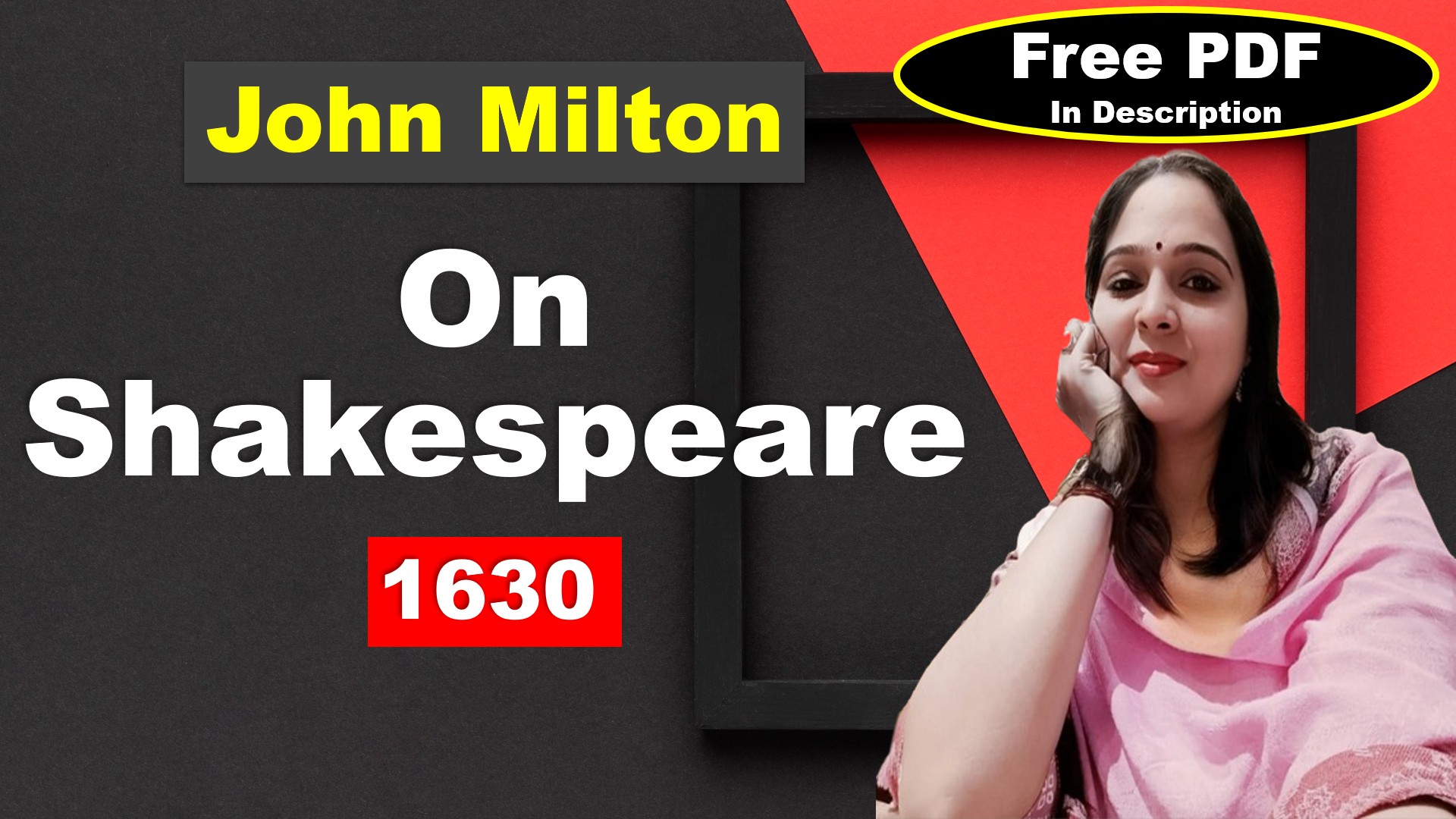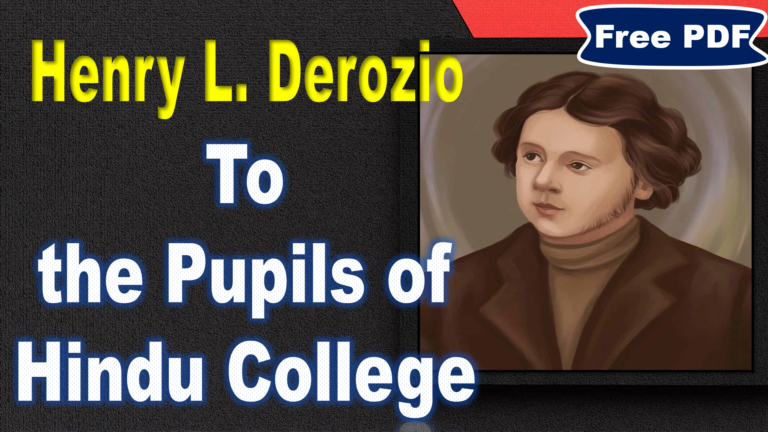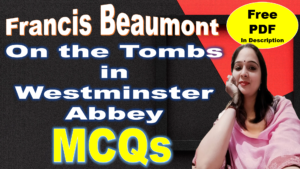Word Meaning
| Line | Word | Meaning | अर्थ |
| 1 | honoured | having or receiving respect | सम्मानित |
| 2 | pilèd | arranged in a heap | ढेर लगा हुआ |
| 3 | hallowed | made holy by religious ceremonies | पवित्र किया हुआ |
| 3 | relics | residue | अवशेष |
| 4 | star-ypointing | pointing towards the stars | तारों की ओर इशारा करता हुआ |
| 5 | heir | a person who is legally entitled to receive property or a title from someone who has died | उत्तराधिकारी |
| 5 | fame | popularity | यश |
| 6 | Need’st | Needst (archaic) | जरुरत |
| 6 | thou | you | तुम |
| 6 | witness | evidence | गवाह |
| 6 | thy | your | तेरा |
| 7 | astonishment | amazement | विस्मय |
| 8 | Hast | Have (used with the second person singular subject, like thou) | |
| 8 | thyself | Himself / themselves | स्वयं |
| 8 | live-long | lasting for a whole lifetime | जीवन भर चलने वाला |
| 9 | whilst | while | जबकि |
| 9 | slow-endeavouring | taking a long time to do something | धीमी गति से चलने वाला |
| 10 | easy | not difficult | आसान |
| 10 | numbers | verses or poetic lines | छंद |
| 11 | Hath | Has (used with the third person singular subject (he, she, it)) | |
| 11 | unvalued | not appreciated or respected | बिना मूल्य का |
| 12 | Delphic | relating to Delphi, an ancient Greek city-state that was home to a famous oracle | डेल्फ़िक |
| 13 | fancy | the ability to think creatively and imaginatively | कल्पना |
| 13 | bereaving | taking away something from someone | लूट लेने वाला |
| 14 | Dost | Do (2nd person singular, present tense) | |
| 14 | conceiving | imagine | कल्पना करना |
| 15 | sepúlchred | buried in a tomb | समाधि में लेटा हुआ |
| 15 | pomp | magnificent ceremony or display | धूमधाम |
| 16 | tomb | grave | समाधि |
On Shakespeare by John Milton Summary
In his poem “On Shakespeare. 1630”, John Milton praises Shakespeare’s greatness and argues that his work is his own best monument. Milton begins by asking what kind of monument Shakespeare needs for his remains, and he suggests that Shakespeare does not need an elaborate physical memorial, because his work is his own best monument.
Milton then goes on to praise Shakespeare’s writing, comparing it to the prophecies of the Oracle of Delphi. He suggests that Shakespeare’s poetry is so powerful that it can overwhelm and astound his readers. Milton also criticizes the slow and laborious process of creating physical monuments, and he suggests that Shakespeare does not need such a monument, because his work is more enduring than any physical structure.
In the poem’s final lines, Milton says that Shakespeare’s tomb is his own poetry, and that kings for such a tomb would wish to die. Milton is suggesting that Shakespeare’s poetry is so great that even kings would wish to be buried in it.
Overall, Milton’s poem “On Shakespeare. 1630” is a powerful and eloquent tribute to Shakespeare’s greatness. Milton praises Shakespeare’s talent and legacy, and he argues that his work is his own best monument.
Key Points
Author The poem was written by John Milton, a renowned English poet and intellectual who lived during the 17th century.
Form This 16-line poem is written in a single stanza. The lines are organized into rhyming pairs, known as heroic couplets. A heroic couplet , to be more particular, is a specific type of couplet that primarily focuses on the heroic themes of someone or something. The rhyme scheme of this poem is AABBCCDDEEFFGGHH. Milton also chose to use iambic pentameter, a common metrical pattern that was also favoured by Shakespeare.
Speaker The speaker in the poem is the poet himself, John Milton.
Setting The setting of the poem is not explicitly mentioned, but it revolves around the speaker’s tribute to William Shakespeare.
Theme The main themes of the poem are admiration, tribute, and the enduring legacy of a great artist.
Plot The poem begins with the speaker stating that no monument is needed for Shakespeare as his works serve as his memorial. The speaker then praises Shakespeare’s genius and his ability to capture the essence of human nature in his works.
Tone The tone of the poem is reverential and admiring, reflecting the speaker’s deep respect for Shakespeare.
Message The message of the poem is that the true monument of a great artist is not a physical structure, but their works that continue to inspire and influence generations.
John Milton
Birth and Early Life: John Milton was born in 1608 in London, England. He was the second of three children..
Education: Milton was educated at home by private tutors until he went to Christ’s College, Cambridge, at age 16. He graduated with a Bachelor of Arts degree in 1629, and received his Master of Arts degree in 1632.
Marriage: Milton was married three times. His first wife, Mary Powell, died in 1652, just three years after their marriage. He then married Katherine Woodcock in 1656, who died in 1658. His third wife was Elizabeth Minshull, whom he married in 1663.
Works: Milton’s works are known for their grandeur, stateliness, and majesty. His use of blank verse, unrhymed iambic pentameter, is a testament to his skill as a poet. His most famous works include “Paradise Lost”, “Paradise Regained”, and “Samson Agonistes”.
Career: Milton is best known for his epic poem “Paradise Lost”. He also wrote other significant works like “Paradise Regained” and “Samson Agonistes”. Besides being a poet, Milton was also a civil servant for the Commonwealth of England under Oliver Cromwell.
Death: Milton died on November 8, 1674.
Legacy: Milton’s influence on English literature and language is profound. His epic poem “Paradise Lost” is considered one of the greatest works of literature. He is remembered for his defense of civil and political rights, and his views on divorce and freedom of the press were revolutionary for his time.










